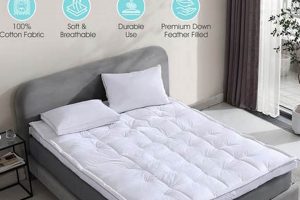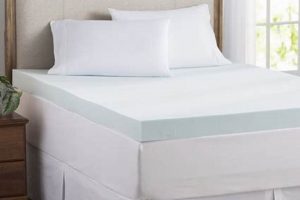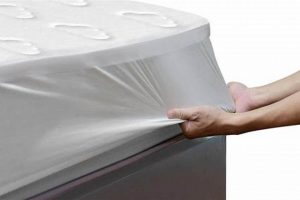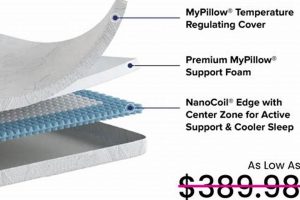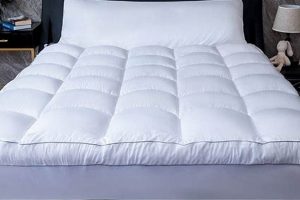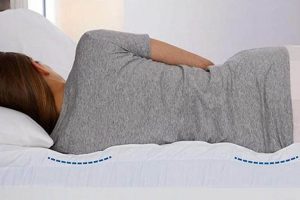A supplementary layer designed to enhance the comfort and support of a bed in hospitality settings. Typically crafted from materials like memory foam, down, or latex, it is placed atop the existing mattress to modify its feel. For example, a firm mattress can be softened with a plush version, contributing to a more restful guest experience.
The incorporation of these additions plays a crucial role in guest satisfaction. By improving sleep quality, they indirectly impact reviews and repeat bookings. Historically, these bedding enhancements were reserved for luxury establishments; however, the demand for comfortable accommodations has led to their widespread adoption across various hotel tiers. Their use demonstrates a commitment to providing a superior sleep environment without the expense of replacing entire mattresses.
The subsequent sections will delve into the various types available, the factors to consider when selecting one for a hospitality environment, and the maintenance practices that ensure longevity and hygiene. Furthermore, cost-benefit analyses and emerging trends in bedding technology will be explored, providing a comprehensive overview of this important element of guest room outfitting.
Selecting and Maintaining Hotel Mattress Toppers
This section provides guidance on the optimal selection and upkeep to maximize guest satisfaction and longevity.
Tip 1: Material Considerations: Prioritize material based on guest preferences and climate. Memory foam offers contouring support, while latex provides breathability and responsiveness. Down alternatives are suitable for allergy-sensitive individuals. Evaluate the density and thickness to achieve the desired firmness level.
Tip 2: Size and Fit: Ensure precise dimensions to avoid slippage or overhang. Measure mattresses accurately and select appropriate sizes. Elastic straps or anchor bands can further secure it in place.
Tip 3: Hygiene and Allergen Control: Opt for hypoallergenic materials and regularly sanitize to mitigate allergens. Invest in waterproof protectors to guard against spills and stains. Rotate and air it out periodically to prevent moisture buildup.
Tip 4: Cost-Benefit Analysis: Consider the long-term value proposition. While premium options offer enhanced comfort, analyze the potential return on investment in terms of positive reviews and increased occupancy rates. Factor in replacement costs and lifespan expectancy.
Tip 5: Regular Inspection: Routinely inspect for signs of wear and tear, such as compression, sagging, or staining. Replace promptly to maintain optimal comfort and hygiene standards.
Tip 6: Rotation Practices: Implement a rotation schedule to distribute wear evenly and extend lifespan. Rotating end-to-end and flipping (if applicable) can prevent localized compression and maintain uniform support.
Tip 7: Professional Cleaning: Schedule periodic professional cleaning to remove accumulated dust, allergens, and stains. Steam cleaning or specialized cleaning agents can effectively sanitize and rejuvenate materials. Follow manufacturer recommendations for appropriate cleaning methods.
Adhering to these guidelines ensures a consistently comfortable and hygienic sleep environment, contributing to positive guest experiences and enhanced brand reputation.
The subsequent section will explore emerging trends in hospitality bedding and strategies for continuous improvement in guest room amenities.
1. Material Composition
The material composition is a foundational determinant of the properties and performance of a hospitality bed enhancement. The selection directly influences factors such as comfort, support, durability, and hygiene. For instance, memory foam, polyurethane-based material, conforms to the body’s contours, distributing weight and reducing pressure points. This can enhance the sleep experience for guests seeking orthopedic support. Latex, derived from rubber trees, offers a responsive and breathable alternative, preferred by those who tend to overheat during the night. Down and feather fills provide a plush feel but require careful allergen management. The inherent characteristics of each material dictate its suitability for different guest preferences and environmental conditions.
Consider a hotel in a humid climate. Using a topper predominantly composed of dense memory foam, with limited breathability, could lead to heat retention and discomfort. Conversely, opting for a latex or gel-infused memory foam alternative addresses this issue by promoting airflow. Similarly, establishments catering to allergy-sensitive guests must prioritize hypoallergenic materials, such as synthetic down alternatives or latex, to minimize the risk of allergic reactions. The denier, thread count, and weave of the fabric encasing the fill material also impact its breathability, durability, and resistance to dust mites.
In conclusion, the material composition is not merely a superficial attribute but a critical engineering parameter of a hospitality bed layer. Understanding the characteristics of various options enables hoteliers to make informed decisions that optimize guest comfort, extend product lifespan, and maintain hygiene standards. Failure to carefully consider this component can lead to dissatisfied guests, increased replacement costs, and compromised brand reputation. The integration of material science principles into the procurement process is therefore essential for effective bedding management in the hospitality industry.
2. Thickness & Density
Thickness and density are fundamental parameters dictating the performance and suitability of a bed enhancement within the hospitality sector. These properties significantly impact comfort, support, and longevity.
- Influence on Comfort and Support
Thickness directly correlates with the amount of cushioning provided. A thicker layer generally offers greater pressure relief, conforming to the body’s contours and reducing stress on pressure points. Density, conversely, determines the level of support. Higher density materials resist compression, preventing the occupant from sinking excessively and maintaining spinal alignment. For example, a high-density memory foam topper, despite being relatively thin, can offer superior support compared to a low-density, thicker down alternative.
- Impact on Heat Retention and Airflow
Thickness and density influence heat retention. Denser materials, particularly memory foam, tend to trap heat. Thicker constructions amplify this effect. However, material composition plays a role. Open-cell foam or gel-infused materials mitigate heat buildup by promoting airflow. Conversely, thinner, less dense options are inherently more breathable. Hotels in warmer climates should prioritize airflow to prevent discomfort.
- Durability and Lifespan Considerations
Density is a primary determinant of durability. Higher-density materials are more resistant to compression and deformation, extending the product’s lifespan. Thicker units, while providing greater initial comfort, may compress over time, especially if constructed from low-density materials. Regular rotation can mitigate uneven wear and prolong the lifespan of the topper.
- Cost and Value Proposition
Thickness and density affect the cost. Generally, thicker and denser materials are more expensive due to the increased material volume and manufacturing complexity. Hotels must evaluate the cost-benefit ratio. A premium, high-density option may offer superior performance and longevity, justifying the higher initial investment. Conversely, a more affordable, thinner option may suffice for budget-conscious establishments or rooms with lower occupancy rates.
The interplay between thickness and density dictates the overall performance characteristics of a bed enhancement. Hotels must carefully consider these parameters in relation to guest preferences, climate, budget constraints, and desired product lifespan. Optimizing thickness and density ensures a balance of comfort, support, durability, and value, contributing to enhanced guest satisfaction and a positive return on investment.
3. Size Compatibility
Size compatibility constitutes a critical factor in the effective deployment of a hospitality bed enhancement. The dimensions must precisely align with the host mattress to ensure optimal comfort, performance, and aesthetic integration within the guest room. An improperly sized topper can lead to several adverse consequences, ranging from diminished support and premature wear to potential safety hazards. For example, an undersized selection will leave portions of the mattress exposed, negating the intended benefits and creating an uneven sleep surface. Conversely, an oversized unit may overhang the edges, presenting a tripping hazard and compromising the overall appearance of the bedding ensemble.
The correlation between precise sizing and guest satisfaction is demonstrably evident in review data. Hotels that prioritize accurate measurements and provide properly fitted enhancements consistently receive higher ratings related to sleep quality and comfort. Standard mattress sizesTwin, Full, Queen, King, and California Kingrequire correspondingly sized overlays. However, variations in mattress depth necessitate careful measurement to ensure a secure and flush fit. Elastic straps or anchor bands can provide additional security, but they cannot compensate for significant size discrepancies. Furthermore, compliance with fire safety regulations mandates that the selected unit not impede access to emergency exits or obstruct sprinkler systems, underscoring the paramount importance of accurate sizing.
The ramifications of neglecting size compatibility extend beyond immediate guest comfort. An ill-fitting enhancement is subject to increased stress and friction, accelerating wear and tear and reducing its overall lifespan. This, in turn, translates to higher replacement costs and increased operational overhead. Therefore, a proactive approach to size verification, coupled with rigorous quality control during procurement, is essential for maintaining optimal bedding standards and ensuring a positive guest experience. Addressing this seemingly minor detail demonstrably contributes to improved guest reviews, enhanced operational efficiency, and sustained profitability within the competitive hospitality landscape.
4. Hygiene Protocols
Strict adherence to hygiene protocols is paramount for any establishment utilizing mattress overlays. These additions, while enhancing comfort, also present a potential reservoir for allergens, bacteria, and bed bugs. The porous nature of many topper materials, such as memory foam and down, facilitates the accumulation of bodily fluids, dust mites, and shed skin cells. Consequently, inadequate hygiene practices can transform a comfort-enhancing amenity into a source of health hazards, negatively impacting guest well-being and hotel reputation. For example, failure to regularly sanitize can lead to the proliferation of mold and mildew, particularly in humid environments, triggering respiratory issues and allergic reactions in susceptible individuals.
Effective hygiene protocols necessitate a multi-faceted approach encompassing regular cleaning, protective encasements, and periodic replacement. Cleaning protocols should include frequent vacuuming with HEPA-filtered equipment to remove surface debris and allergens. Stain removal requires the use of appropriate cleaning agents that disinfect without damaging the material. Waterproof and bed bug-proof encasements serve as a physical barrier, preventing fluids and pests from penetrating the topper and contaminating the mattress. Periodic replacement, typically every one to three years depending on usage and wear, is essential to mitigate the buildup of contaminants and maintain optimal hygiene levels. A prominent hotel chain, faced with a bed bug infestation traced to inadequately maintained bed enhancements, implemented a comprehensive hygiene program involving quarterly deep cleaning and annual replacement of all topper units, successfully eradicating the problem and restoring guest confidence.
In summary, robust hygiene protocols are not merely an adjunct to the utilization of mattress enhancements; they are an indispensable component. Proactive measures, including consistent cleaning, protective barriers, and timely replacement, are crucial for safeguarding guest health, preserving the lifespan of the bedding investment, and upholding the reputation of the establishment. Neglecting these essential practices risks compromising the very benefits the enhancement is intended to provide, transforming a comfort asset into a potential liability.
5. Longevity & Cost
The interplay between durability and price represents a critical decision point for hospitality businesses considering the integration of bed enhancements. An initial emphasis on minimizing expenditure may prove detrimental in the long term if the chosen product exhibits substandard resilience. Premature degradation necessitates more frequent replacements, thereby negating any perceived cost savings. For example, a lower-priced topper constructed from inferior materials may exhibit significant compression within a year, requiring immediate replacement. Conversely, a higher-priced alternative, fabricated from high-density memory foam or resilient latex, could maintain its supportive properties for several years, offering a more favorable return on investment. The impact of frequent replacements extends beyond the direct cost of the item; it also encompasses labor expenses associated with installation and disposal, as well as potential disruptions to room availability.
The characteristics of selected materials, cleaning protocols, and usage patterns directly influence its lifespan. Rigorous cleaning procedures, while essential for hygiene, can accelerate the degradation of certain materials if inappropriate cleaning agents are employed. High-traf
fic rooms, experiencing greater occupancy rates, will naturally subject the units to increased wear and tear. Furthermore, the quality of the mattress upon which the enhancer is placed plays a role; a worn or sagging mattress can exacerbate the compression of the upper layer, shortening its useful life. Hotels can mitigate these factors through proactive maintenance programs, including regular rotation to distribute wear evenly and the use of protective encasements to minimize soiling and physical damage. Cost-benefit analyses that incorporate projected lifespan, cleaning expenses, and potential guest satisfaction impacts provide a more accurate assessment of the overall value proposition.
Ultimately, a strategic approach to bedding enhancements necessitates a comprehensive understanding of the relationship between longevity and cost. Short-sighted procurement decisions, driven solely by price, can lead to a cycle of frequent replacements and escalating operational expenses. Investments in durable, high-quality options, coupled with diligent maintenance practices, offer the potential for long-term cost savings and improved guest satisfaction. Challenges related to balancing upfront investment with projected returns can be addressed through thorough product research, vendor consultations, and careful consideration of the specific demands of the hospitality environment. By prioritizing long-term value over immediate cost reductions, establishments can optimize their bedding investments and enhance the overall guest experience.
Frequently Asked Questions
The following addresses common inquiries regarding the selection, utilization, and maintenance of the additions in hospitality settings. The information is intended to provide clarity and guide informed decision-making.
Question 1: What is the typical lifespan?
The expected lifespan varies considerably based on material composition, usage intensity, and maintenance practices. High-density memory foam or latex units, with proper care, may last three to five years. Lower-quality options or those subjected to heavy use may require replacement within one to two years.
Question 2: How does it impact guest satisfaction?
A properly selected and maintained enhancement demonstrably improves sleep quality and comfort, directly contributing to positive guest reviews and repeat bookings. Conversely, a worn or unsuitable unit can detract from the guest experience.
Question 3: What are the key considerations when selecting one?
Material, thickness, density, size, and hygiene are paramount considerations. Material should align with guest preferences and climate. Thickness and density dictate support and comfort levels. Precise sizing prevents slippage. Hypoallergenic materials and robust cleaning protocols are essential for hygiene.
Question 4: What cleaning methods are recommended?
Regular vacuuming with HEPA filters is essential. Stain removal should be performed with appropriate cleaning agents that do not degrade the material. Steam cleaning can effectively sanitize. Manufacturer instructions should be consulted for specific recommendations.
Question 5: What is the role of protective encasements?
Waterproof and bed bug-proof encasements provide a crucial barrier against spills, stains, and pest infestations, extending the lifespan and improving hygiene. These encasements should be regularly cleaned and inspected for damage.
Question 6: How does its usage impact cost?
While initial cost is a factor, the long-term cost-benefit analysis should consider lifespan, cleaning expenses, and potential impacts on guest satisfaction and occupancy rates. Investing in higher-quality units with longer lifespans can often prove more economical.
In conclusion, effective management requires a holistic approach that integrates informed selection, diligent maintenance, and a clear understanding of the factors influencing lifespan and cost. Prioritizing guest comfort and hygiene while optimizing operational efficiency is essential for maximizing the value of these hospitality investments.
The subsequent section will explore emerging trends in bedding technology and strategies for continuous improvement in guest room amenities.
Conclusion
The preceding discussion elucidates the multifaceted considerations surrounding the selection, implementation, and maintenance of hotel mattress topper in the hospitality industry. Key factors such as material composition, thickness, density, size compatibility, and hygiene protocols have been examined, underscoring their individual and collective influence on guest satisfaction, operational efficiency, and long-term cost effectiveness. A comprehensive understanding of these elements is essential for informed decision-making and optimal resource allocation.
Strategic procurement and diligent maintenance of hotel mattress topper represent a tangible commitment to guest well-being and service excellence. Continued innovation in bedding technology necessitates ongoing evaluation and adaptation to ensure the delivery of a superior and consistently comfortable sleep experience. The pursuit of excellence in this domain remains a crucial differentiator in an increasingly competitive market landscape.


